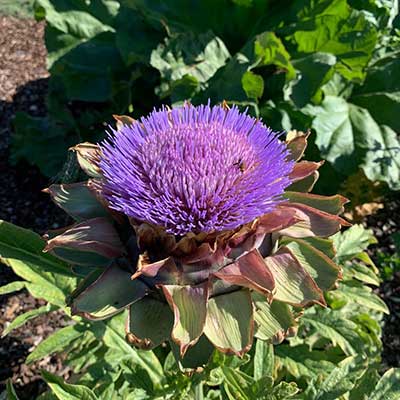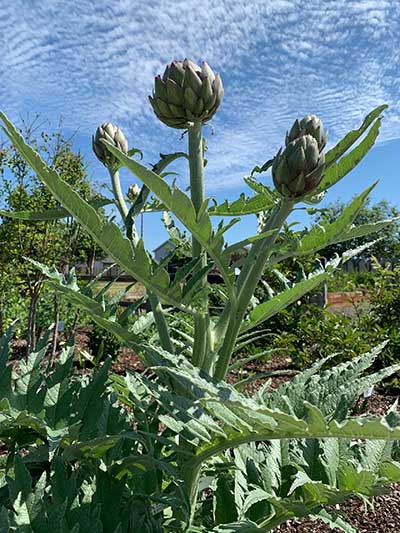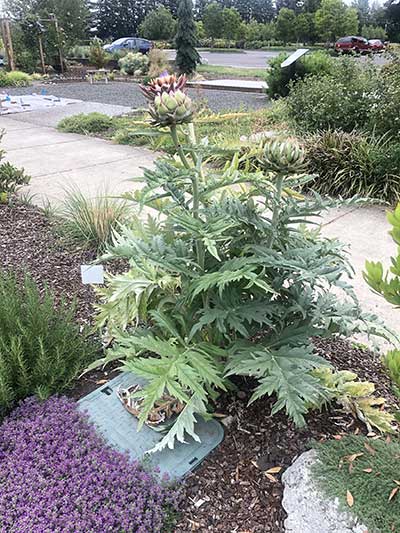Artichoke
- Scientific Name: Cynara scolymus
- Garden: Edibles and Herbs Garden
- Plant Type: Herbaceous Perennials
- Evergreen/Deciduous: Evergreen
- Sun/Shade Exposure: Full Sun
- Moisture Requirements: Moist, Well-Drained
Plant Information
Artichokes are Mediterranean plants that thrive in full, hot sun. They need a minimum of six hours of direct sun a day at the peak of summer. A rich, well‐drained soil is ideal. In the Portland area, seeds can be started indoors February through April (two months before the average last frost date), and directly outdoors starting in May. Transplant starts in late spring when the ground has warmed up and there is no chance of frost. Give plants 3’ spacing and full sun. A site protected from winter winds and extreme cold is best. Amend soil with 2” of compost and/or manure before planting. Add an organic transplanting fertilizer to the bottom of the hole. Once planted, top‐dress with good mulch, making sure not to smother the crown. WATER REQUIREMENTS Artichokes like moist soil, but never soggy. When watering, drench the root area completely. Frequency of watering varies with every situation. In the heat of summer, it may need a thorough drink once a week. Watering frequency will decrease during cooler weather and as plants become established. Artichokes are very drought tolerant once established after the first year. Water a second-year plant thoroughly in the hottest summer months. A third-year plant should be fine without additional water. In containers, artichokes will need regular watering weekly before the soil pulls away from the sides of the container. Artichokes in containers will need regular water for life because they will have a restricted root system. FERTILIZING Artichokes benefit from an annual feeding in the spring, side‐dress with kelp meal or any other all-purpose granular fertilizer. A 1” layer of composted manure also works. HARVESTING & STORAGE Newly planted artichokes begin to produce edible heads early to mid-summer. Established plants can start flowering in late spring. Harvest before the outer “petals” have begun to open, cut buds with 1” of stem along with it. Store in refrigerator; lasts up to a week or more. PESTS & DISEASES *Snails and slugs leave large holes in leaves when they feed at night. Slug baits, and beer traps are just a few ways to control them. *Verticillium and Bacterial Wilt are soil borne virus which cause the plant to suddenly wilt. Remove and destroy infected plant. Replant a new plant in a different area (or container). *Die out‐ All artichokes have a limited life span and lose vigor, dying away after 5 years of production. *Gray Mold shows as brown spots on buds which develops a white or gray mold in wet weather. Remove infected buds, avoid overhead irrigation and improve air circulation. Treat healthy foliage with a fungicide if desired. *Aphids often appear as a black coating on the flower buds. Also, sticky sap on leaves and stems and white aphid skeletons are quite prevalent. There are numerous sprays and control measures to help combat aphids. Garlic and cayenne sprays help deter them, and insecticidal soap kills them when spayed every 7‐10 days. *Earwig damage appears as holes bored through the base of the buds. Set traps for earwigs made out of rolls of corrugated cardboard. Earwigs will hide in the cardboard in the day. In the morning shake the traps into a bucket of soapy water or simply discard away from the garden. WINTER PROTECTION Cut artichoke foliage to the ground in late fall. Artichokes in containers need protection at temperatures around 25°F or colder. In the ground a thick layer of straw will help insulate the root mass for the winter. The key for survival in the ground is great drainage and temperatures above 20°F.
Data Source
https://www.portlandnursery.comPlant Photos









